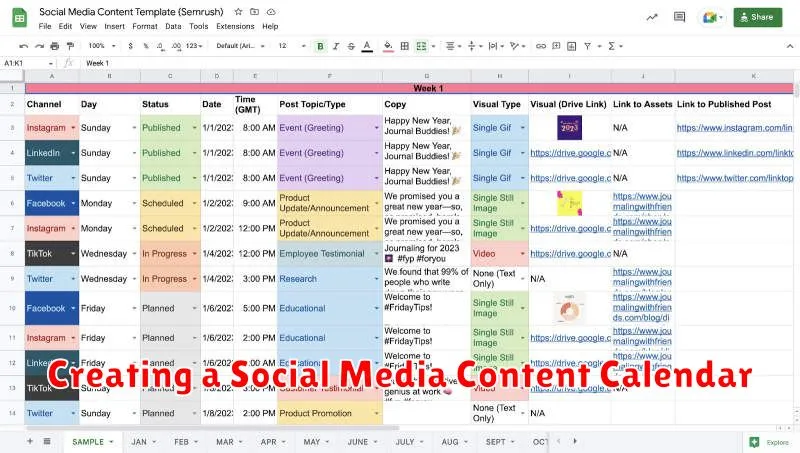In today’s digital landscape, a robust social media presence is no longer optional but essential for business success. However, simply existing on social media platforms is not enough. To truly harness the power of social media marketing, you need SMART goals – goals that are Specific, Measurable, Achievable, Relevant, and Time-bound. This guide will provide a comprehensive framework for setting SMART social media marketing goals that drive measurable results and contribute to your overall business objectives. Learn how to move beyond vanity metrics and focus on key performance indicators (KPIs) that truly matter, enabling you to optimize your social media strategy for maximum impact.
Developing SMART goals for social media marketing is the cornerstone of a successful strategy. Without clearly defined objectives, your efforts can become fragmented and ineffective. This guide delves into the nuances of each component of a SMART goal, providing practical examples and actionable steps for implementation. From increasing brand awareness and driving website traffic to generating leads and boosting sales, learn how SMART social media goals can transform your online presence and deliver tangible results. Discover how to leverage the power of data-driven decision making to refine your approach and achieve your social media marketing objectives.
Defining Your Target Audience
Before launching any social media campaign, it’s crucial to define your target audience. Understanding your audience is the foundation of effective social media marketing. Without a clear picture of who you’re trying to reach, your efforts will likely be scattered and ineffective.
Defining your target audience involves identifying key demographics such as age, gender, location, education, and income level. Beyond demographics, consider their psychographics – their interests, values, lifestyle, and online behavior. Where do they spend their time online? What kind of content do they engage with? What are their pain points and needs?
Creating detailed buyer personas can be a helpful exercise. A buyer persona is a semi-fictional representation of your ideal customer. Give your persona a name, a background, and specific details about their motivations and challenges. This will help you tailor your social media content and messaging to resonate with your target audience.
Establishing Clear and Measurable Objectives
After defining your target audience, the next crucial step is establishing clear and measurable objectives. These objectives should directly support your overall business goals and provide a roadmap for your social media activities. Vague objectives lead to vague results. Specificity is key.
Begin by identifying what you want to achieve through social media. Do you aim to increase brand awareness, generate leads, drive website traffic, or boost sales? Each objective requires a different approach and set of metrics. For example, if your goal is to increase brand awareness, you might focus on metrics like reach, impressions, and social mentions.
Measurable objectives are essential for tracking progress and demonstrating ROI. Quantify your objectives whenever possible. Instead of aiming to “improve customer engagement,” aim to “increase comment volume by 25% in the next quarter.”
Key Performance Indicators (KPIs) for Social Media Success
Choosing the right Key Performance Indicators (KPIs) is crucial for measuring the effectiveness of your social media strategy. KPIs provide quantifiable data that demonstrates progress toward your objectives.
Reach measures how many unique users see your content. A larger reach indicates greater brand visibility.
Engagement encompasses actions users take on your content, such as likes, comments, shares, and saves. High engagement suggests your content resonates with your audience.
Website traffic from social media reveals how effectively your social channels are driving users to your website, where they can take valuable actions like making a purchase or signing up for a newsletter.
Conversion rates track the percentage of users who complete a desired action after clicking on a social media link. This KPI directly reflects the effectiveness of your social media marketing in driving business outcomes.
Selecting the most relevant KPIs depends on your specific business goals. For example, an e-commerce business may prioritize conversion rates and website traffic, while a brand-building campaign might focus on reach and engagement.
Creating a Social Media Content Calendar

A social media content calendar is a critical tool for organizing and scheduling your social media posts. It provides a structured plan, ensuring consistent posting and helping you maintain an active presence across your chosen platforms.
Begin by choosing a format. This could be a simple spreadsheet, a specialized social media management tool, or even a dedicated calendar application. The key is to find a system that works for you and your team.
Populate your calendar with planned content, including the date and time of posting, the specific platform being targeted, and the content itself. Consider the following elements when planning your content:
- Key dates and events relevant to your industry or audience
- Promotional campaigns or product launches
- Recurring content themes or series
Regularly review and adjust your content calendar as needed. This allows you to stay adaptable and responsive to current events, trending topics, and audience feedback. A well-maintained content calendar contributes significantly to a successful social media strategy.
Developing Engaging Content that Resonates with Your Audience
Creating compelling content is crucial for social media success. Content should be tailored to your target audience’s interests and preferences. Understanding their demographics, online behavior, and pain points is essential.
Variety is key. Experiment with different content formats such as text posts, videos, images, and stories. Ask questions, run polls, and host live sessions to foster interaction and gather valuable feedback.
Prioritize high-quality visuals. Eye-catching images and videos can significantly increase engagement. Ensure visuals are relevant to your message and brand aesthetic.
Storytelling is a powerful tool. Share compelling narratives that connect with your audience on an emotional level. Authenticity and transparency are essential for building trust and rapport.
Analyzing and Reporting on Your Social Media Performance
Analyzing and reporting are crucial steps in determining the effectiveness of your social media strategy. Regularly reviewing your performance data helps you understand what’s working, what’s not, and how to optimize your efforts.
Begin by utilizing the analytics dashboards provided by each social media platform. These dashboards offer valuable insights into metrics such as reach, engagement, and follower growth.
Track key performance indicators (KPIs) aligned with your objectives. For example, if your goal is to increase brand awareness, focus on metrics like reach and impressions. If driving website traffic is the objective, track click-through rates.
Consolidate your data into a single report. This provides a comprehensive overview of your performance across all platforms and allows for easier identification of trends and patterns. Consider using a spreadsheet or reporting software to organize your data.
Regular reporting is essential for demonstrating the value of your social media efforts and informing future strategies. Share your findings with stakeholders to keep them updated on progress and demonstrate return on investment (ROI).
Adapting Your Strategy Based on Data and Insights
Social media marketing requires continuous adaptation. Analyzing data and insights is crucial to understanding what’s working and what’s not. This information empowers you to refine your strategy for optimal performance.
Regularly review your key performance indicators (KPIs). Are you meeting your targets for engagement, reach, and conversions? If not, identify the areas needing improvement.
Data-driven decisions are key. For instance, if your audience isn’t responding to a particular content format, experiment with alternatives. Perhaps video content performs better than static images, or vice-versa. Use A/B testing to compare different approaches.
Be prepared to pivot your strategy based on the insights gathered. This might involve adjusting your content calendar, targeting different demographics, or experimenting with new platforms. Flexibility is crucial in the ever-evolving social media landscape.
By continuously monitoring, analyzing, and adapting, you ensure your social media efforts remain effective and aligned with your overall marketing objectives.
Best Practices for Setting Realistic and Achievable Goals

Setting realistic and achievable social media marketing goals is crucial for long-term success. Avoid setting overly ambitious goals that are difficult to attain. Start small and gradually increase your targets as you achieve milestones. This fosters a sense of accomplishment and keeps your team motivated.
Prioritize your goals and focus on a few key areas for improvement. Trying to tackle too much at once can lead to scattered efforts and diluted results. Concentrate your resources on the most impactful activities.
Regularly review and adjust your goals. Social media landscapes are constantly evolving. What worked last quarter might not be as effective today. Stay adaptable and be willing to modify your strategy based on performance and industry trends. This ensures your goals remain relevant and contribute to your overall marketing objectives.
Benchmark against your competitors to understand industry standards and identify areas for growth. This analysis provides valuable context for setting realistic targets and measuring your progress against others in your field.

